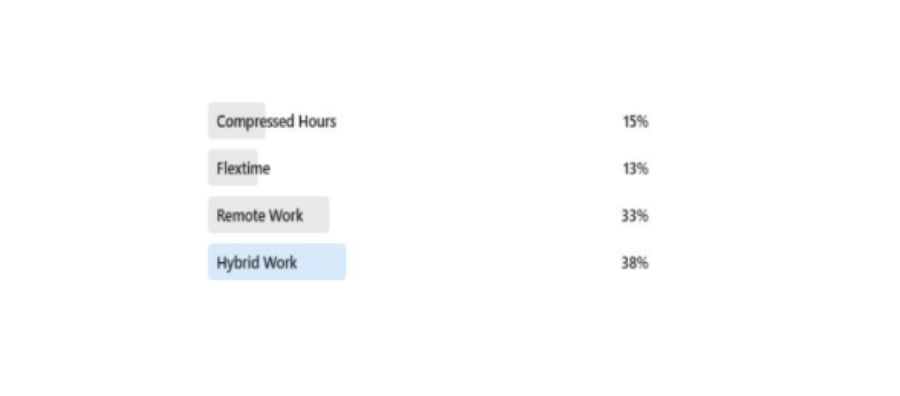COVID-19 created a radical re-evaluation of working patterns. At short notice a large percentage of employees traditionally office-based were now working fully remotely. Many have settled into permanent remote or hybrid working utilising technological advancements that have supported flexible working arrangements and are embracing the work-life balance flexible working offers.
Supporting work-life balance attracts and retains talent:
- Employees are more likely to be motivated, engaged and loyal, in turn supporting productivity and business success
- It contributes to an employer’s wider equality, diversity and inclusion (EDI) strategy, using flexible working to promote fairness and inclusion across a workforce, supporting employees with different needs
- It removes barriers to employment for those whom, without flexibility, may be prohibited from work opportunities
- It opens up new talent markets across diverse areas of the country
Brightmine’s recent survey of 398 UK organisations, found flexible working can be hugely beneficial for organisations, 92% of respondents, across varied business sizes, reporting at least some benefits. The most commonly mentioned related to improved mental health and wellbeing (53%). For some, such as neurodivergent and disabled employees, being in the office everyday can be challenging. For employees with caring responsibilities not having access to flexible working can cause considerable anxiety and financial implications. Inflexible working arrangements can lead to a loss of productivity and burnout. For employers there is the risk that people may quit their jobs and seek employment with an organisation that offers a more flexible approach.
Analysis of Google Trends data has revealed that searches for ‘remote jobs’ soared in the UK by 94 per cent at on 5th March 2025. This may be attributed in part to the recent budget announcements with increased employer national insurance costs and the cost-savings remote based roles offers employers.
Sammons Pensions Recrutment conducted a poll March 2025 on ideal working patterns:

The results show hybrid work is the most favoured option, closely followed by remote. Recent CIPD data indicates strong employer support for hybrid working despite some well-publicised examples of organisations asking staff to return to the office full-time. CIPD’s Labour Market Outlook survey found widespread adoption of hybrid working, with positive ratings for remote performance and benefits such as attraction, retention, employee satisfaction and business flexibility.
Ben Willmott, head of public policy at the CIPD highlights the urgency for reducing the number of individuals dropping out of the workforce due to health conditions. “We welcome the final report published by the Commission for Healthier Working Lives, which the CIPD supported,” says Willmott. “With around 300,000 people a year dropping out of the workforce with a work-limiting health condition, the report highlights the need for urgent reform to support more people with health issues to remain in work. It calls for a new partnership between government, businesses and individuals to deliver the long-term changes needed. Creating healthier work has to go hand in hand with building better-managed and more productive workplaces, with a strong focus on building people management competence.”
International Workplace Group (IWG) research suggested hybrid work is considered nearly twice as important as parental leave in supporting women in the workplace. The study, based on responses from more than 1,000 female workers, found that 67% believe hybrid work has positively influenced their career trajectory. Only 36% said the same for parental leave. The main benefits of hybrid work include improved work-life balance (58%), greater flexibility (58%) and reduced commuting time (54%) due to the ability to work closer to home.
A separate IWG study found that 69% of flexible businesses reported increased productivity and the same proportion said flexibility had helped them attract and retain top talent. Research by McKinsey further supports this, showing that companies with more than 30% female representation are more likely to outperform those with fewer women in senior roles.
- Gender Parity and Career Progression: The study concludes that hybrid working plays a key role in advancing gender equality in the workplace. 49% of respondents said hybrid work had contributed to their promotion to a more senior role, 48% cited increased flexibility as a crucial factor in their career advancement. Across all age groups, 68% of women agreed that flexible working had helped level the playing field at work. However, progress remains slow. According to the World Economic Forum, gender parity will not be achieved until 2158 at the current rate. 52% of women in the IWG study believe flexibility will be essential in closing this gap.
- Hybrid Work and Productivity: 81% of women reported being more productive when given the flexibility to choose their work location. Findings from Stanford Professor Nicholas Bloom indicate that hybrid work models improve productivity by 3 to 4 percent on average, with long-term impacts on business performance.
- Retention: Commuting remains a major challenge for many women, particularly those balancing work with family responsibilities. 63% said hybrid work had enabled them to remain in employment rather than leaving due to caregiving commitments. 65% of female employees aged 35-44 (a critical period for career progression and higher earning potential) stated they would leave their job if required to commute long distances daily. 84% said flexibility influenced their decision when applying for a role.
As the workplace continues to evolve, with new technological advancements, changing employee attitudes and the phasing out of traditional structures, embracing flexibility and supporting employees’ wellbeing will be crucial for organisational success.

Current flexible working rules:
Employees are eligible to make a flexible working request from day one of employment and can make up to two requests every 12 months. Employers must deal with flexible working requests in a “reasonable manner” and within two months of receipt. 10 October 2024, the Government presented the Employment Rights Bill to Parliament. Under the Bill, an employer may still refuse a flexible working request on one of the current grounds, but only if it is reasonable to do so. The employer must state the ground(s) for refusing the application and the reason(s) it considers its refusal to be reasonable. The Government says that these changes will establish flexible working as the default except where it is not reasonably feasible.